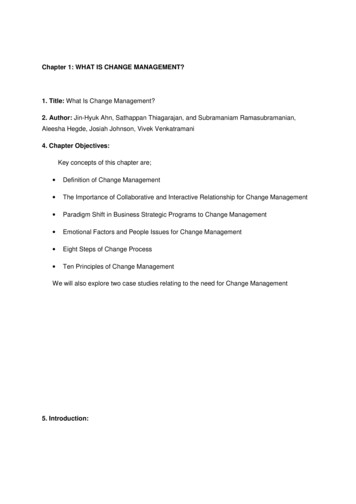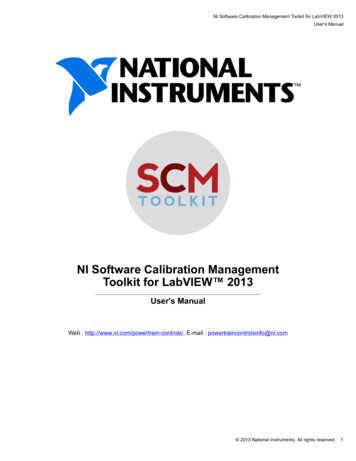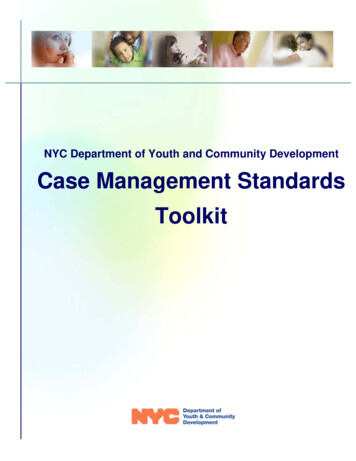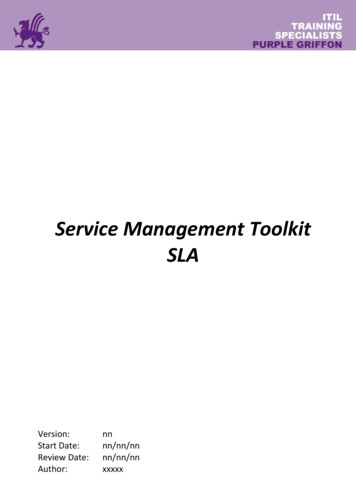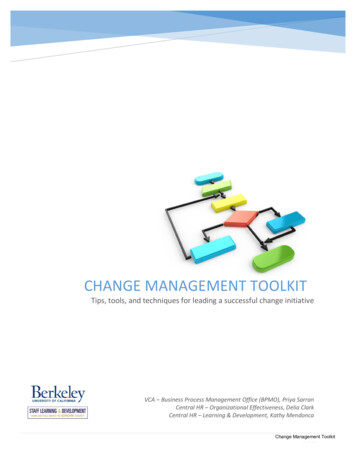
Transcription
CHANGE MANAGEMENT TOOLKITTips, tools, and techniques for leading a successful change initiativeVCA – Business Process Management Office (BPMO), Priya SarranCentral HR – Organizational Effectiveness, Delia ClarkCentral HR – Learning & Development, Kathy MendoncaChange Management Toolkit0 Page
Table of ContentsHow to Use this Toolkit . 2Why Change Management?. 3What happens if a Necessary Change Management Component is missing? . 4Change Management Pre-work . 5To Change Behavior – Direct the Rider . 6Case for Change Template . 7Compelling Vision Interview Template . 8Working with Your Sponsor Overview . 9Sponsor Expectation Tool . 10Stakeholder Analysis and Engagement Plan Overview . 11Stakeholder Analysis and Engagement Plan Template . 15Change Readiness Assessment (baseline). 16Behavioral Change Plan . 17Team Communication Overview. 19Team Communication Plan . 20Manage Personal Transitions (resistance) . 21To Change Behavior – Motivate the Elephant . 22Transition Model (Bridges). 23Change Process Model (Kubler-Ross) . 24Change Process Model – Indicators & Strategies (Kubler-Ross) . 25Core Values Exercise . 27Best Practices for Leading Change – What to Do . 28Best Practices for Leading Change – What NOT to Do . 29Develop Change Plan . 30To Change Behavior – Shape the Path . 31Implementation Strategies . 32Risk Assessment Template . 33Success Metrics Overview . 35Success Metrics Template . 36Feedback Strategy Overview . 37Feedback Strategy Options . 38Change Communications Plan Overview . 40Change Communications Plan Template . 41Change Communication Brief Template . 45Implement & Monitor the Change. 46To Sustain the Change – Keep the Momentum Going . 47Change Readiness Assessment (final check before pilot/big bang) . 48Monitor Metrics for Continuous Improvement . 49Change Management Toolkit1 Page
How to Use this ToolkitWhy is a change management toolkit necessary?In the 21st century we are surrounded by constant innovation, technology enhancements, and a connectionto a global network, all of which has created a new normal of perpetual change. As a way of handling theincreased volume of change, a plethora of proven tools and techniques have been created to aidindividuals in managing change. As a result of these tools and techniques being globally socialized andtested, the necessary components for effectively managing change are known. These proven tools andtechniques have been reviewed and curated into this toolkit which contains those most appropriate for useat UC Berkeley.Who is this toolkit for?This toolkit is designed for any individual responsible for leading a change initiative of any size.How to use this toolkit?This toolkit begins with an introduction to the importance of change management and goes over the sevencomponents necessary to effectively manage change. It is organized into four main sections:(1)(2)(3)(4)Change Management Pre-workManage Personal Transitions (resistance)Develop Change PlanImplement & Monitor the Change.Each of these sections contain a collection of tools and techniques which organize the work needed for thechange initiative and they are best followed chronologically.While a multitude of tools are provided, not all tools will be necessary for every change. When consideringwhich tools to use, review the scope of the change identified in the Project Charter. For large scaleinitiatives, it is recommended that all tools be used in each section of the toolkit. For small to medium sizedinitiatives, at a bare minimum, the following tools should be used: Case for change template (page 7)Compelling vision Interview template (page 8)Change communication plan overview & template (pages 40-41)Change Readiness assessment (page 16)Manage Personal Transitions (resistance) Section (pages 21-29)Feedback Strategy Overview & Options (pages 37-38)Behavioral change Plan (page 17)Change Management Toolkit2 Page
Why Change Management?As a top-ranked public research university, UC Berkeley serves as a flagship institution when it comes to our bold and innovativeinitiatives. Change management is often the key component in driving the success of these ventures. As we know from our ownexperience, not all change initiatives are equally disruptive. Some will have a greater impact and be more challenging. Others may bebarely noticeable.Change can be bucketed into two main categories: Incremental and Transformational. Incremental change is easier to implementsuccessfully. It is often based on the current state in order to improve the existing way of doing our work. It typically involves fewerchanges and affects a small number of people. On the other hand, Transformational change is more difficult to implement, typicallyhaving only a 30% success rate. (Taking Stock survey by The Change Management Toolbook, February 2005) Why is that?Things get more challenging when the change is Transformational because it is designed from a future state and involves afundamentally new way of doing things. This typically involves significant culture change and affects a large number. The complexityinvolved in culture change is often why it is easier to change the change than it is to change the culture.Culture is our values, beliefs, assumptions, and unwritten rules. These shape our behaviors and mindset as well as our performance.Individuals within an organization co-create the culture through conversations and by following behavioral norms. In addition to theoverarching culture of an organization, individual subcultures often exist. Taking both of these into consideration for your particularinitiative is necessary when determining how to approach a change for your area.Since there are many complexities involved in executing a change initiative, both change management and project managementcomponents are required. Sometimes change management and project management are mistaken as one in the same whenactually they are two complimentary yet different disciplines. Both utilize formal processes, tools, and techniques to plan for thechange, manage the change, and sustain the change. While change management focuses on ensuring the support of the people,project management focuses on the work tasks to be executed. Coupled together, proactive change management and projectmanagement will lead to the actualization of the benefits of the change initiative.The one common denominator to achieve success for all change initiatives is people. According to Chip and Dan Heath, authors ofSwitch, peoples’ brains have two independent systems at work at all times: the rational side (is reflective, it deliberates, analyzes,and looks to the future), and the emotional side (is instinctive, feels pleasure and pain). Think of the rational side of the brain as theRider and the emotional side of the brain as an Elephant. The Rider’s strength is to think and to plan. Without a plan there is no pathto get things done. The Elephant’s strength is emotion. Without emotion there is no motivation (no energy) to get things done.To change behavior (our own or someone else’s), we must do three things:1. Direct the Rider – make the destination crystal clearThe Rider has their own issues. A Rider likes to contemplate and analyze information before deciding on adirection. When a Rider isn’t sure exactly which direction to go, they lead the Elephant in circles. Often,what looks like resistance is actually lack of clarity.2. Motivate the Elephant – make people feel the need for changeWhen an individual’s six-ton Elephant is not in agreement with the direction their Rider wants to go, theRider is going to lose. The Rider may get their way temporarily, through close monitoring and exerting selfcontrol, but in the long term the Elephant will ALWAYS overpower the Rider. Why? Self-control is anexhaustible resource. Often what looks like resistance is actually exhaustion. Motivation provides theenergy the Rider needs to maintain self-control; a lack of motivation may doom a change effort.3. Shape the Path – make the required changes specificTo direct the Rider and motivate the Elephant, we need to shape the Path by focusing the situation,including the surrounding environment, to make the change more likely. Being specific narrows the focus,so the Elephant and the Rider are more likely to stay traveling together toward the goal. Often, what lookslike resistance is actually lack of direction.Heath, Chip, and Dan Heath. Switch: How to Change Things When Change Is Hard. Thorndike Press, 2011Change Management Toolkit3 Page
What happens if a Necessary Change Management Component is missing?Industry statistics show that only 30% of organizational change initiatives are successful. For a change initiative to be regarded as successful, the desired objectives of the effortmust be fully realized. The reason 70% of change initiatives fail is because organizations do not engage in effective change management. There are seven necessary componentsof change management. If any component is neglected, the result will be a less than optimal achievement of the initiatives goals. The below graphic illustrates the sevencomponents required for successful change management and indicates specific consequences that occur when a component is missing. To assist you in proactively addressingeach component, relevant remedies from the Toolkit are provided.Adapted from: Linkage, Inc. “Leading Change and Managing Transitions.” Leading Change and Managing Transit
Why is a change management toolkit necessary? In the 21st century we are surrounded by constant innovation, technology enhancements, and a connection to a global network, all of which has created a new normal of perpetual change. As a way of handling theFile Size: 1MBPage Count: 51

